List of Authors
>>About this blog
Recent blog post
|
[Silver]
Nov. 28, 2016 14:00
Outside of Tsukiji Fish Bank, "Tsukiji Fish Bank" opened, and the arrival on the day of opening was 15:15, I could not enter, so I went on November 26.
First of all, when trying to go up to the third floor by the escalator, two scary demon masks   and beautiful Akita. and beautiful Akita.
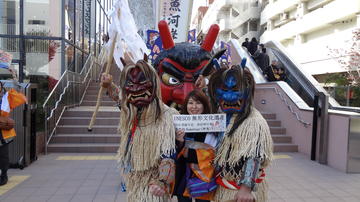
The third floor is a rooftop plaza, and this time, Akita Prefecture and Tottori Prefecture co-hosted the "Hatahata Festival 2016".
A fish called Hatahata is written as san. God's God joins the fish bias. This fish belongs to the squirrelidae family, and in Akita Prefecture, it rushes into the shallow sea near the Oga Peninsula and lays eggs. The fishing season is from November to December, and thunder fish called Hatahata is written as san. God's God joins the fish bias. This fish belongs to the squirrelidae family, and in Akita Prefecture, it rushes into the shallow sea near the Oga Peninsula and lays eggs. The fishing season is from November to December, and thunder  often starts to ring at this time, so it is said that such kanji came to be applied. At one time, I heard that fishing could only be obtained about 20 tons, but now about 800 tons are caught. In Tottori Prefecture, hatahata fishing seems to be popular. There were a lot of shops. I tasted and purchased nanban pickles of Hatahatahata. often starts to ring at this time, so it is said that such kanji came to be applied. At one time, I heard that fishing could only be obtained about 20 tons, but now about 800 tons are caught. In Tottori Prefecture, hatahata fishing seems to be popular. There were a lot of shops. I tasted and purchased nanban pickles of Hatahatahata.  It's It's   an appetizer for tonight's sake. an appetizer for tonight's sake.
After entering the room through the rooftop plaza, you will find cafes, curry (curry), fried goods, and Chinese restaurants on your right hand.
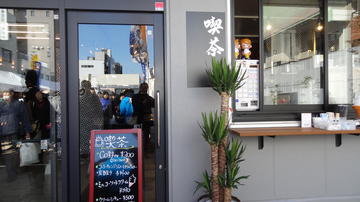
At the restaurant of Kuchirin (curry), beef bowl and Hayashi 600 yen. Curry 550 yen, curry and palm match 650 yen, curry and beef bowl match 750 yen, Hayashi and beef bowl match 800 yen. There are plenty of toppings. There are fried food and Chinese restaurants.
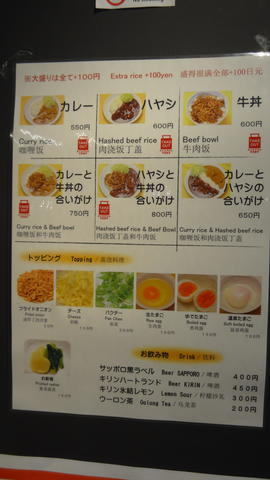
At the fried food shop, charsew egg set meal is 1,250 yen, sashimi set meal is 1,350 yen, and fried set meal is 1,450 yen.
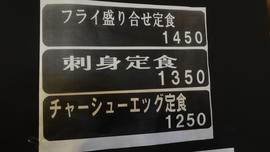
And there is a Chinese restaurant.
On the left side, there is a restaurant with reasonable prices of seafood bowls. "Ara cooked set meal 800 yen" seems to be very popular.
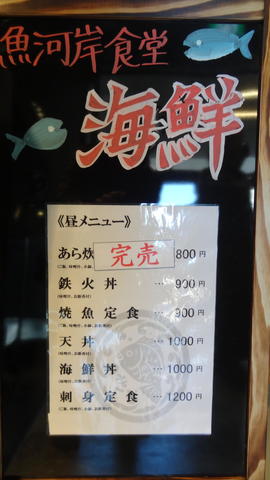
The second floor is a dedicated space for those who are opening stores on the Tsukiji Fish Bank.
I went around the shop on the first floor from the Odawarabashi building (along Harumi-dori St.).
In Kikuichi on the left immediately after entering, Japanese spiny lobster, who lived in the aquarium, was swimming.
Delicious tuna sashimi is sold, and specialty shops for salmon and fillets are also available.
I purchased salmon fillets and Gindara fillets at Kitada Fisheries.
You will enter the Kaisaibashi building across the Namiki-dori street. (You can also go from Haji Shrine)
There are many tuna specialty stores, and you can see the dismantling of tuna seriously. (It's not a demolition show.) This is tuna caught in Shiogama Port, Miyagi Prefecture.
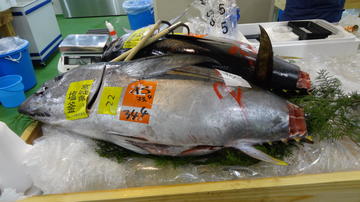
Located in S03, "Daisei Honten" is a boiled octopus specialty store founded in 1922.
In addition to the boiled octopus, octopus octopus rice 600 yen, octopus rice rice 200 yen, and sea bream rice 600 yen are also popular.
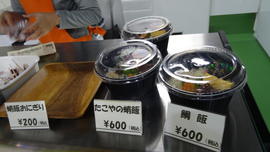
Tsukiji Hokuei, located in N16, sold "Tsukiji Grocke" in addition to fresh tuna sashimi. It seems that this is registered as a trademark in (Maguro Menchi). If you buy 2 or 3, it's cheaper.
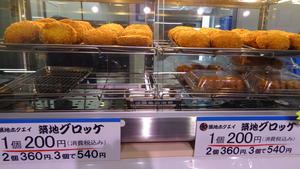
By the way, today, I purchased san's Nanban pickles, Oma's tuna sushi, octopus rice, Hokkaido's seasonal salmon, and Alaska's silver cod cake. I thought it would take some time to be good at shopping. I'll come again.
Important Notice
Business hours are from 5:00 a.m. to 3:00 p.m. on the first floor. The third floor is from seven a.m. to two p.m. : "General customers should come after 9 a.m.."
Closed days are Sunday, public holidays, and Wednesday, and are the same as the Central Wholesale Market.
For more information, please visit the website of Tsukiji Fish Bank. http://www.tsukiji.or.jp/forbiz/uogashi/
[Sam]
Nov. 26, 2016 14:00
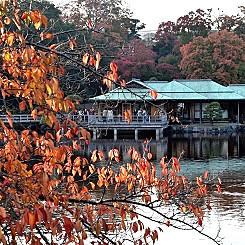 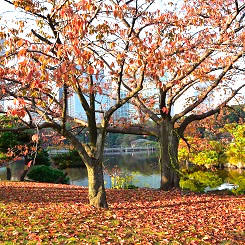
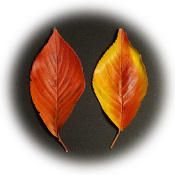 There is also the word "Sakura Momiji", and the autumn leaves of Yoshino cherry tree are said to be as beautiful as Iroha maple, but in terms of attention, the fact is that they worship the dust. There is also the word "Sakura Momiji", and the autumn leaves of Yoshino cherry tree are said to be as beautiful as Iroha maple, but in terms of attention, the fact is that they worship the dust.
The autumn leaves of Iroha maple are wonderful not only in the delicate shape of individual leaves and the changing colors, but also in the cohesion of the entire tree.
On the other hand, in the case of Yoshino cherry tree, when it comes to autumn leaves, the leaves turn red, and the leaves fall one after another.
The whole tree lacks unity, and the impression that it has been saved cannot be wiped out.
It is also called a week point because the leaves are slightly thick and the back has a sober color, and the vividness of redness does not stand out even when viewed through the sunshine.
However, there are various kinds of leaves in Yoshino cherry tree, such as red, brown and yellow, and gradation can be seen in one leaf.
I hear that the traces of insect bites are also one of the beauty of modeling.
If you pick up the laid fallen leaves, you can rediscover individual differences.
It is a point of viewing the autumn leaves of Yoshino cherry tree, which is a bit different from the maple maple.
At the Hamarikyu Onshi Garden, you can enjoy the calm late autumn atmosphere, which is different from the gorgeous scenery of spring.
[Silver]
Nov. 26, 2016 12:00
Huffman and Jeffrey, who are teaching English at St. Luke's International University, participated in a seminar titled "Let's Develop a Global Self" on November 17.
Under the theme of learning English, he taught me the motivation, reason, and efficacy of learning English. Why do we learn English? learning English, he taught me the motivation, reason, and efficacy of learning English. Why do we learn English?
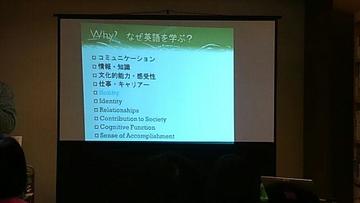
1)Communication, 2) Acquisition of information and knowledge, 3) To enhance cultural skills and sensitivity, 4) to improve work and career.
5)For my hobbies, I taught me that there are various things such as 6) Identity, 7) Relationships, 8) Contribution to Society, 9) Cognitive Function, and 10) Sence of Accomplishment.
9)In the explanation of the Cognitive Functions, the Company explained
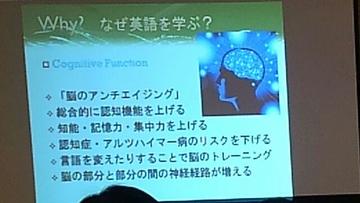
"Anti-aging of the brain", "Improve cognitive ability comprehensively", "Improve intelligence, memory, and concentration", "Improve the risk of dementia and Alzheimer's disease", "By changing language, I learned that it is effective for training  and increasing the neural path between the brain and part. It's just a good thing and increasing the neural path between the brain and part. It's just a good thing . .
By all means, I would like to brush up my English and entertain visitors.
It was a very useful lecture.
Thank you very much.
[Silver]
Nov. 26, 2016 12:00
This year, the "Gathering of International Exchange" by the Chuo-ku Cultural and International Exchange Promotion Association was held on Saturday, November 19 at Tsukiji Education Center. .
First of all, we finished the reception on the first floor and headed to the cooking class on the 4th floor.
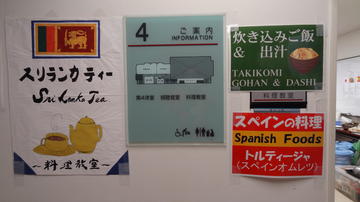
Spanish omelet, cooked rice, and clear bonito soup stock.
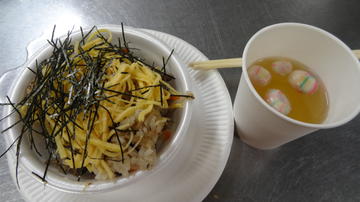
After the meal, Sri Lankan milk tea was very delicious. People from foreign countries were also smiling.
On the second floor, hula dance.
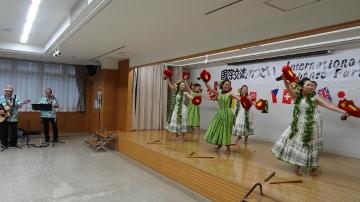
Continuing from last year, a flamenco show by Tomoko Ishii flamenco Studios.
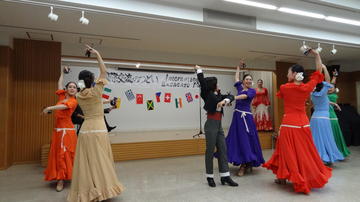
And I was taught a beginner flamenco for our beginners. Ole' 
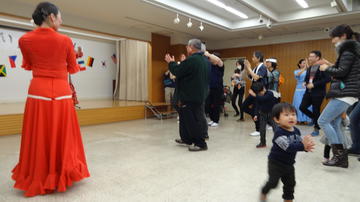
I participated in this year's "Marugoto Museum" and conveyed the wonderfulness of flamenco to the general public. It is said that 70-year-old and 80-year-olds also attend lessons at the great studio. How about you? I'll try it too. Click here for the website of the studio. http://www.tomokoishii.com/ studio. How about you? I'll try it too. Click here for the website of the studio. http://www.tomokoishii.com/
And Bon festival dance by people from Chuo-ku. Everyone was dancing happily to songs such as "This is the Bon Dance in Edo".
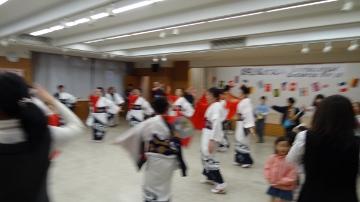
On the same second floor, there was an introduction corner of the sister city of Australia, and everyone was learning with interest.
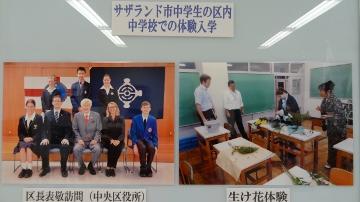
In addition, there was a corner for playing in Japan where children could enjoy, and laughter was echoing with lucky laughter, quoits, daruma drops, beanbags, etc.
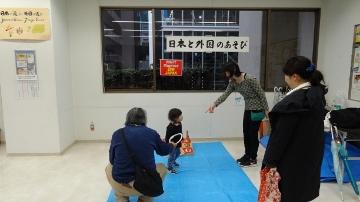
On the 3rd floor, there is a dressing class for foreigners, ikebana experience, and so on.
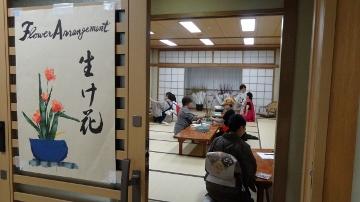
Tea ceremony and tea ceremony experience, ink painting, origami, and furoshiki classes were offered.
On the first floor, wadaiko performances were held, and foreigners also played a flute and explained the music in English.
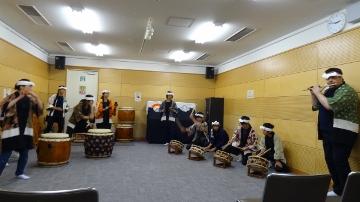
I realized that deep international exchange is taking place.
At the disaster prevention corner on the 4th floor, there were emergency food tasting corners in the event of a disaster and maps about evacuation site, which were also appreciated by foreigners living in Chuo-ku.
I would like to express my deep appreciation and respect to the Chuo-ku Cultural and International Exchange Promotion Association, which is held every year. Thank you very much.
[Sam]
Nov. 25, 2016 18:00
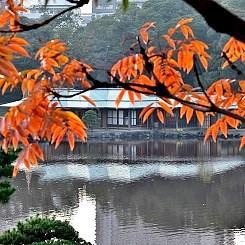 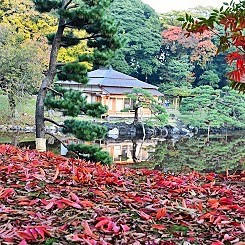
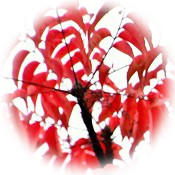 Hasenoki (Haji tree) is deciduous Takagi of the family Urushi. Hasenoki (Haji tree) is deciduous Takagi of the family Urushi.
It's also known as squirrel. It is said to be native to Indochina, China, and was first introduced from Ryukyu, so it is also called Ryukyuhaze.
What can be seen in the mountains of Kyushu from Honshu today is thought to be that what was planted to collect wood wax has escaped.
The leaves are odd feathered compound leaves consisting of 4 to 6 pairs of leaves, gathering near the tip of the branch. dioecious.
At the Hamarikyu Onshi Garden, the autumn leaves of Hakkeiyama and Gozenoki at Mt. Ochinyama are at their best around the tide pond (Oizumi).
There is a time when the "foliage" that leaves the green are mixed, and as the autumn leaves progress, the whole gradually changes from a little modest scarlet to a bright red red-red red color.
Hazemomiji, which beautifully turns red in the world of Haiku, is called Hazemomiji, and is considered a seasonal word for autumn, but it is a tasteful autumn leaves.
The exact color of the song "I found a small autumn" is the perfect color for the lyrics "Haze leaf red and I entered the day ...".
When photographed with backlight, the autumn leaves become even more prominent.
Around the goby tree at Hakkeiyama overlooking the Tsubame Ochiya, the fallen leaves fill their feet like a red carpet, and the sign of late autumn is thick.
[Nojinya]
Nov. 25, 2016 14:00
Large and long-lasting shaking at dawn (November 22). 。 。 It's been a big earthquake since a long time. Fortunately, there seems to be no direct human damage related to life and death so far, but it was a morning when I was reminded of Japan, a country with many disasters (earthquakes, tsunamis, typhoons, etc.).
For Japan, where the number of foreign tourists is rapidly increasing, it is of course important to introduce content such as history and culture, but also to provide information on disaster preparedness and safety in Japan, especially earthquakes and typhoons. It is also important to give a sufficient explanation of the safety in Japan to inbound tourists who are unfamiliar with disasters, and to have them visit with peace of mind in the future.
It seems that the earthquake has subsided, so when I cross Minami Takahashi near my house for work, the sluice gate from the Kamejima River, which should normally open, to the Sumida River, is closed on a street such as the Nihonbashi Cruise. Is it prepared for the tsunami? (The Japan Meteorological Agency sent tsunami advisory to Uchibo and Izu Islands in Chiba Prefecture at 7:26 am.)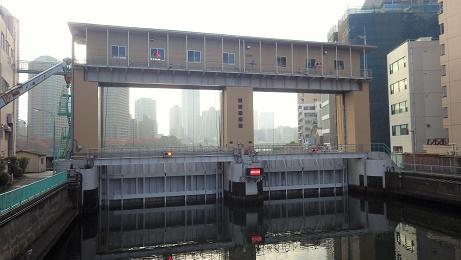
The Kamejima River Sluice Gate is a tide gate created to protect the Kamejima River basin from storm surge damage. The downtown area of Tokyo, which has developed by reclaiming the Hibiya cove since the Edo period, has long been a lot of storm surges and tsunamis. I've been suffering from flood damage. Chuo-ku is also located in areas with relatively low ground heights, and is no exception in this case.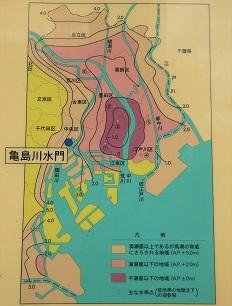
For example, there is a story called "Tsunami" in Seicho Matsumoto's short story book "Mujukujinbetsu Book" (Bunshun Bunko), which was introduced in a blog post I wrote earlier (/archive / 2014/06/post-2075.html), but here, a tsunami depicts a people's footing in Ishikawajima during the Edo period. After the Meiji era, coastal areas such as the Sumida River in the eastern lowland of Tokyo became flooded areas such as floods and storm surges, and storm surge countermeasures were promoted after severe damage such as the Kitty Typhoon (1949) that hit the Kanto area. Will be
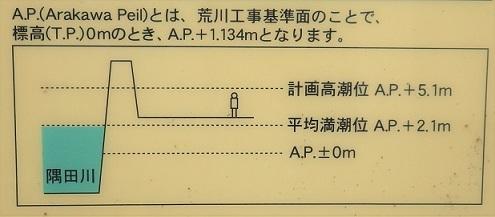
In particular, the storm surge of A.P. + 5.02m in the Nagoya area due to the typhoon in Ise Bay in 1960 (A.P. is "Arakawa Construction Standard Surface". It is determined at the lowest water level of water level station, Reigishi Island in Shinkawa. See the figure above. In the 1960s, the construction of seawalls, the so-called razor dike, began in Tokyo. The Kamejima River Sluice Gate was also completed in 1969 at this time. The gate of the sluice gate is 8.3m, which can prevent storm surges from entering the Kamejima River as well as seawalls. As a result of these measures, when Typhoon No. 20 hit in October 1979, a storm surge (A.P + 3.55m) exceeding the Kitty Typhoon was recorded, but the lives of the local residents were protected without breaching.
It was a Kamejima River sluice gate that I rarely see, but as in this case, when a tsunami or storm surge occurred due to an earthquake or typhoon, etc. and the water level of the river rises, the sluice was closed as soon as possible to prevent flooding and protect the safety of residents and visitors to Chuo-ku. .
[Kamejima River Sluice Gate]
Location 2-31-22 Shinkawa, Chuo-ku, 104-0033, Japan
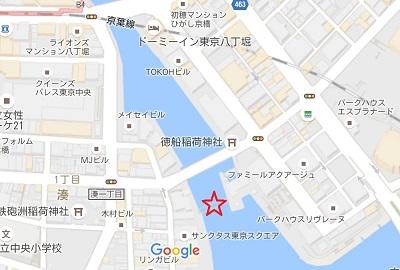
|
Links
|
![]()
![]() and beautiful Akita.
and beautiful Akita.![]()
![]() fish called Hatahata is written as san. God's God joins the fish bias. This fish belongs to the squirrelidae family, and in Akita Prefecture, it rushes into the shallow sea near the Oga Peninsula and lays eggs. The fishing season is from November to December, and thunder
fish called Hatahata is written as san. God's God joins the fish bias. This fish belongs to the squirrelidae family, and in Akita Prefecture, it rushes into the shallow sea near the Oga Peninsula and lays eggs. The fishing season is from November to December, and thunder![]()
![]() often starts to ring at this time, so it is said that such kanji came to be applied. At one time, I heard that fishing could only be obtained about 20 tons, but now about 800 tons are caught. In Tottori Prefecture, hatahata fishing seems to be popular. There were a lot of shops. I tasted and purchased nanban pickles of Hatahatahata.
often starts to ring at this time, so it is said that such kanji came to be applied. At one time, I heard that fishing could only be obtained about 20 tons, but now about 800 tons are caught. In Tottori Prefecture, hatahata fishing seems to be popular. There were a lot of shops. I tasted and purchased nanban pickles of Hatahatahata. ![]() It's
It's ![]()
![]() an appetizer for tonight's sake.
an appetizer for tonight's sake.









 There is also the word "Sakura Momiji", and the autumn leaves of Yoshino cherry tree are said to be as beautiful as Iroha maple, but in terms of attention, the fact is that they worship the dust.
There is also the word "Sakura Momiji", and the autumn leaves of Yoshino cherry tree are said to be as beautiful as Iroha maple, but in terms of attention, the fact is that they worship the dust.













 Hasenoki (Haji tree) is deciduous Takagi of the family Urushi.
Hasenoki (Haji tree) is deciduous Takagi of the family Urushi.




